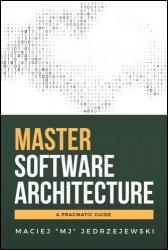 Название: Master Software Architecture: A Pragmatic Guide
Название: Master Software Architecture: A Pragmatic GuideАвтор: Maciej ”MJ” Jedrzejewski
Издательство: Leanpub
Год: 2024-10-08
Страниц: 400
Язык: английский
Формат: pdf (true), epub
Размер: 51.4 MB
Tired of architecture books that read like academic papers? This pragmatic guide will show you how to design robust systems that work in the real world. I have learned these lessons the hard way so you don't have to. Everything you need to know about software architecture—from core principles to advanced patterns—explained in plain English and practical examples.
This book covers a comprehensive range of topics related to software architecture, but it cannot cover them all. Over the decades, the scope has grown to an unimaginable size. I have gathered all the key elements that have accompanied me over the past few years and described them here, ensuring you have a solid foundation to build on.
This book takes a holistic approach to software architecture, so expect discussions on topics like business analysis or documentation of architectural decisions. We will also dive into infrastructure, security, deployments, and application structure. Additionally, I will introduce you to various engineering practices that, while not directly related to architecture, influence it. My goal is to explain each topic clearly for easy understanding.
The world of software architecture is vast and ever-expanding. I am certain I will leave out many exciting topics, so I ask for your understanding, dear reader. You can read the book cover to cover, following the logical progression of the chapters. Alternatively, feel free to jump into a specific part or chapter that interests you. The choice is yours!
Feeling lost in the world of software architecture? This software architecture book is for you!
Years ago, I felt lost when I started in software architecture. There were so many topics and issues, and I was a novice architect in the middle. I didn't know where to start building applications, what key areas to pay attention to, or how to build systems that would be able to evolve over many years.
I have spent countless hours and days learning to recognize this area, and it has not been easy—knowledge was scattered throughout the Internet, books, and tutorials. Finally, mentors helped me get on the right track.
That's why I decided to write this software architecture book. I want to help you navigate this complex world of hard decisions, trade-offs, and techniques that will support you in this fantastic journey. I wish you didn't have to make the same mistakes as me and give up your private life by spending many hours looking for the right information. Each step describes practically the most important aspects of software architecture.
Contents
Step 1: Understand Software Architecture: In this step, you will learn the basics of software architecture, covering key areas like business analysis, solution architecture, and infrastructure. You'll understand the role of software architects, their influence on architectural decisions, and the impact of drivers like functional requirements, technical constraints, and quality attributes while exploring how pragmatism and holism shape these decisions.
Step 2: Discover Your Business Domain: Next, we will explore the critical aspect of system design: the business domain. Through workshops on Event Storming and Domain Storytelling, you will learn to analyze processes, discover subdomains, define bounded contexts, and create a context map (strategic Domain-Driven Design).
Step 3: Recognize the Environment Around You: Step three focuses on understanding your work environment, including decision-making processes, project goals, budget limitations, and differing expectations of stakeholders and development teams. You will assess team skills with a competency matrix, plan infrastructure for various team setups, and learn to calculate crucial metrics like active users, request numbers, and SLA-defined availability, then apply this knowledge to a practical case.
Step 4: Choose Deployment Strategy: In this step, we explore the technical aspects of software architecture, focusing on single and multiple deployment unit strategies and their most popular representatives: modular monoliths and microservices. You will learn about communication methods, database design, deploying changes, scaling applications, and key patterns like outbox, inbox, and dead letter queue.
Step 5: Define Release Strategy: Step five focuses on delivering new application versions using strategies like basic, blue-green, canary, and rolling deployments and leveraging continuous delivery and deployment. You will adopt engineering practices such as swarming, pair and mob programming, feature flags, trunk-based development, and short-living branches. You will also learn how to organize post-mortem meetings to analyze past production issues and prevent future ones. I will also show you how to handle changes in the database in case of various versions of the application,
Step 6: Focus On Testing: This step covers different ways to test your software, focusing on key concepts from a software architect’s perspective. You will learn about the pyramid of tests, the inverted pyramid, the diamond, when to use each, penetration, performance, and load testing to ensure software reliability.
Step 7: Evolve Your Architecture: This step highlights that architecture evolves over time, focusing on four key steps: simplicity, maintainability, growth, and complexity. You'll learn helpful concepts like CQRS, database replicas and sharding, and tactical Domain-Driven Design to ensure your application's robustness and support informed decision-making as it evolves with the business.
Step 8: Don't Forget About Security: In the final step, you will learn about common security vulnerabilities in greenfield and legacy applications, such as IDOR, supply chain attacks, SQL injection, XSS, and DDoS. You'll also explore defense strategies, misconceptions leading to vulnerabilities, and the differences between encoding, encryption, and hashing to select the appropriate mechanism for your needs.
Extra 1: Other Engineering Practices: This section covers important engineering practices that didn't fit into the main body of the book. You'll learn about metrics, developer carousels, effective use of vertical slices in product design, and managing technical debt.
Extra 2: Architecture Exercises: To master software architecture, you need to put theory into practice. I have prepared several real-world scenario exercises to challenge you, validate your understanding, and highlight areas for further study, enhancing your learning journey.
Скачать Master Software Architecture : A Pragmatic Guide
[related-news] [/related-news]
Комментарии 0
Комментариев пока нет. Стань первым!















